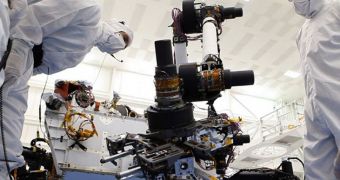For the first time ever, researchers in charge of handling the construction of the next American rover on Mars announce that the robotic arm on the explorer has begun moving.
This is tremendous news for all the teams involved in the construction process, as it represents an important milestone in the mission's time line.
At this point, the machine is scheduled to launch towards the Red Planet in August 2010, scientists say. According to analysts, chances are high that this deadline will be met.
Despite initial cost overruns and delays caused by technological glitches, the project to build the Mars Science Laboratory (MSL) is now heavily underway, and progressing smoothly.
The instrument will be called Curiosity, and it will be powered by a nuclear engine. However, its most important components would be its scientific tools, which represent the very reason the MSL is being built.
One of the most important payloads will be the robotic arm, which experts plan to use for a wide variety of tasks. In the development efforts, actually moving the arm represents a huge step forward, as well as a validation of efforts the team made thus far.
The arm was attached to the main frame of the machine in August 2011, and experts at the NASA Jet Propulsion Laboratory (JPL) have been working on getting it online ever since.
Due to the intricate nature of the tasks it will be used for, the robotic device is very difficult to put together. The sheer number of connections is overwhelming.
One of its main tasks will be to collect samples, and then placing them inside the rover's body. There, especially-built ovens will heat up the soil or rock samples, and try to determine whether any signs of past or current life exist within.
In this sense, this is the first rover to be sent on the Red Planet with the specific purpose of tracking down any possible signs of life.
Given the geology of the planet, which was heavily scrutinized using past missions, experts believe that Mars may have at one point provided all the necessary conditions for supporting life.
This included a warmer climate, as well as a large ocean, which may have covered an impressive swath of its northern hemisphere.
Under these circumstances, it stands to reason that at least simple bacteria may have developed there. It's Curiosity's job to try and identify such traces.

 14 DAY TRIAL //
14 DAY TRIAL //